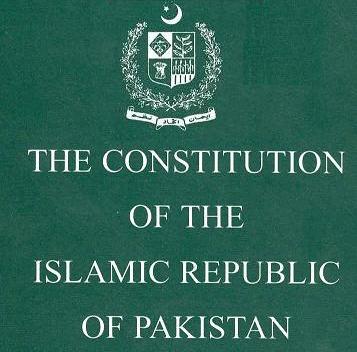Discuss the salient features of the 1973 Constitution of Pakistan.
Salient Feature of the 1973 Constitution of Pakistan:
The present Constitution is the third constitution of the country which was drafted and passed by the National Assembly of Pakistan on April 10, 1973. It was authenticated by the president on April 12, 1973 and enforced on August 14, 1973. Following are the main characteristics of this constitution.
1) A Written Constitution
The Constitution of 1973 is written with a preamble, 280 Article, 6 Schedules and a few Amendments. Political Usage’s and Traditions are yet to emerge and develop side by side with the constitution of Pakistan.
2) Flexibility
The Constitution is neither too rigid like the American Constitution nor too flexible like the British Constitution. It can he amended if 2/3 majority of the total strength of the National Assembly approves an amendment in it and when the same is absented to by the Senate with majority of its total strength.
3) Republican Form of Government
According to the Constitution, Pakistan shall be an Islamic Republic. The Head of the State shall be elected by the parliament in a joint sitting for a term of five years. He may be re-elected for another term also.
4) Federal Form of Government
Pakistan shall be a Federation consisting of the provinces of Sind, Punjab, N.W.F.P and Baluchistan. Powers of the Federation have been enumerated in the Federal Legislative list part-I and II and residuary powers belong to the provinces Powers common to both the federal and the provincial Governments have been enumerated in the Concurrent List.
5) Parliamentary Form of Government
The Constitution provides for Parliamentary form of Government both at the centre and in the provinces. Both the Prime Minister and the Chief Ministers are held responsible to the National and Provincial Assemblies. They continue in office as long as they command confidence of the assemblies.
They may be removed by the assemblies through a vote of No-Confidence.
6) Bicameral Legislature
The Legislature will Bicameral. The Lower House is called the National Assembly directly elected by the people on the basis of one man one vote for a term of 5 years. The upper House is called the Senate elected by the Provincial Assemblies on the basis of Proportional Representation. The National Assembly is subject to dissolution but not the Senate.
7) Fundamental Rights
The Constitution grants and protects the fundamental rights of the citizens of Pakistan. They include the right to life, property, profession, liberty of thought and expression, freedom of association, religion, equality of citizens etc. In case of their violation, the affected person may go to the Courts for seeking redress of his grievances.
8) Pakistan to be a Welfare State
The Constitution reflects the spirit of a Welfare State. It provides that •illiteracy shall be removed; educational and economic interests of backward classes and areas shall be promoted; just and human conditions of work shall be provided; prostitution, gambling and consumption of alcoholic liquor shall be prohibited and well-being of the people, irrespective of caste, sex, creed or race will be secured by raising their standard of living. Basic necessities of life like food, housing, clothing, education, and medical relief shall be provided to the citizens who are permanently or temporarily unable to earn their livelihood.
9) Independence of Judiciary
Although the members of the judiciary are appointed by the president yet the powers to remove them from their offices have not been given to him for ensuring independence of judiciary. The judges can be removed by the president only when the Supreme Judicial Council of Pakistan so advises him. The Constitution also provides independence of the judiciary from the Executive.
